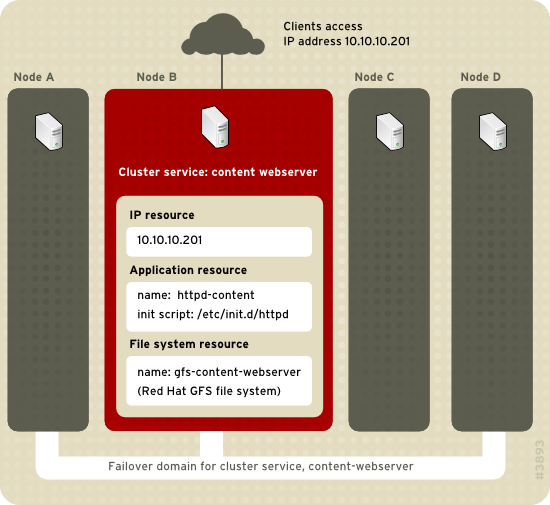이 콘텐츠는 선택한 언어로 제공되지 않습니다.
1.4. High-availability Service Management
High-availability service management provides the ability to create and manage high-availability cluster services in a Red Hat cluster. The key component for high-availability service management in a Red Hat cluster,
rgmanager, implements cold failover for off-the-shelf applications. In a Red Hat cluster, an application is configured with other cluster resources to form a high-availability cluster service. A high-availability cluster service can fail over from one cluster node to another with no apparent interruption to cluster clients. Cluster-service failover can occur if a cluster node fails or if a cluster system administrator moves the service from one cluster node to another (for example, for a planned outage of a cluster node).
To create a high-availability service, you must configure it in the cluster configuration file. A cluster service comprises cluster resources. Cluster resources are building blocks that you create and manage in the cluster configuration file — for example, an IP address, an application initialization script, or a Red Hat GFS shared partition.
You can associate a cluster service with a failover domain. A failover domain is a subset of cluster nodes that are eligible to run a particular cluster service (refer to Figure 1.10, “Failover Domains”).
Note
Failover domains are not required for operation.
A cluster service can run on only one cluster node at a time to maintain data integrity. You can specify failover priority in a failover domain. Specifying failover priority consists of assigning a priority level to each node in a failover domain. The priority level determines the failover order — determining which node that a cluster service should fail over to. If you do not specify failover priority, a cluster service can fail over to any node in its failover domain. Also, you can specify if a cluster service is restricted to run only on nodes of its associated failover domain. (When associated with an unrestricted failover domain, a cluster service can start on any cluster node in the event no member of the failover domain is available.)
In Figure 1.10, “Failover Domains”, Failover Domain 1 is configured to restrict failover within that domain; therefore, Cluster Service X can only fail over between Node A and Node B. Failover Domain 2 is also configured to restrict failover with its domain; additionally, it is configured for failover priority. Failover Domain 2 priority is configured with Node C as priority 1, Node B as priority 2, and Node D as priority 3. If Node C fails, Cluster Service Y fails over to Node B next. If it cannot fail over to Node B, it tries failing over to Node D. Failover Domain 3 is configured with no priority and no restrictions. If the node that Cluster Service Z is running on fails, Cluster Service Z tries failing over to one of the nodes in Failover Domain 3. However, if none of those nodes is available, Cluster Service Z can fail over to any node in the cluster.
Figure 1.10. Failover Domains
Figure 1.11, “Web Server Cluster Service Example” shows an example of a high-availability cluster service that is a web server named "content-webserver". It is running in cluster node B and is in a failover domain that consists of nodes A, B, and D. In addition, the failover domain is configured with a failover priority to fail over to node D before node A and to restrict failover to nodes only in that failover domain. The cluster service comprises these cluster resources:
- IP address resource — IP address 10.10.10.201.
- An application resource named "httpd-content" — a web server application init script
/etc/init.d/httpd(specifyinghttpd). - A file system resource — Red Hat GFS named "gfs-content-webserver".
Figure 1.11. Web Server Cluster Service Example
Clients access the cluster service through the IP address 10.10.10.201, enabling interaction with the web server application, httpd-content. The httpd-content application uses the gfs-content-webserver file system. If node B were to fail, the content-webserver cluster service would fail over to node D. If node D were not available or also failed, the service would fail over to node A. Failover would occur with no apparent interruption to the cluster clients. The cluster service would be accessible from another cluster node via the same IP address as it was before failover.

